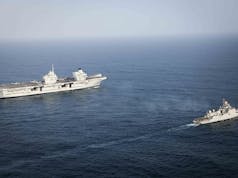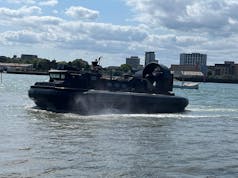The Joint Expeditionary Force (JEF) has initiated a month-long series of protective military activities involving multiple maritime and air units to secure critical undersea infrastructure across Northern Europe, according to a press release.
This operation, named NORDIC WARDEN, involves ships, aircraft, and personnel from JEF participant nations, operating in various areas from the North Atlantic Ocean to the Baltic Sea. The activities are coordinated by the JEF from Northwood Headquarters in the UK.
Group Captain Kevin Latchman, JEF Director of Communications, stated, “NORDIC WARDEN builds on the success of JEF’s first-ever response option last year, also focused on critical undersea infrastructure, and is part of a systematic approach to understand and respond to potential threats. Importantly, JEF is working with other stakeholders who are also working hard to contribute in this area.”
NORDIC WARDEN combines capabilities from JEF nations to monitor shipping activity near important undersea energy and communications routes, and to coordinate the detection and interdiction of any unusual or suspicious activity in these areas. Since 2023, NATO and its allies have increased patrols in the Baltic Sea, following damage to undersea infrastructure in the region, and have enhanced surveillance and reconnaissance flights with maritime patrol aircraft and NATO AWACS planes.
Critical undersea infrastructure is vital for economic activity among the interconnected nations of northern Europe. Any disruption to this infrastructure, whether deliberate or accidental, could significantly impact the daily lives of the region’s populations. The JEF’s activities underscore its collaboration with NATO, which serves as the region’s ultimate security guarantor.
In early 2023, NATO established the Critical Undersea Infrastructure Coordination Cell at NATO Headquarters. This centre engages with industry and brings together key military and civilian stakeholders to share best practices and leverage innovative technologies to enhance the security of allied undersea infrastructure. In May 2024, experts from across the alliance convened the first meeting of NATO’s Critical Undersea Infrastructure Network, reflecting the alliance’s commitment to securing undersea cables and pipelines and monitoring potential threats.
The JEF is a multinational coalition of ten Northern European nations committed to democracy, human rights, and the rule of law. The JEF participant nations are Denmark, Estonia, Finland, Iceland, Latvia, Lithuania, the Netherlands, Norway, Sweden, and the UK.














What does it take to prevent another Nordstream attack and outage?
The West could not blow up another pipe line. Why would the Russians blow up Nordstream when all they had to do was turn off the gas. Western sanctions have pushed Russia further into China’s pocket while making my house colder in the winter.
Contracts of supply have very specific responsibilities for each party and exclusions that likely include acts of God, and acts of War or Terror.
So the Terrorist State can evade their responsibilities with plausible denied acts of terrorism. That saves them Billions that they probably don’t have and certainly don’t want to spend.
Financial markets, commodity speculators are responsible for the price of your energy since RF Urals grade junk (sanctioned) doesn’t heat your home.
If they do detect some nefarious activity…frog-persons, uuv, xluuv, or 4xl atomic muv (manned underwater vehicle), what do they do about it?
Presumably the new ships have a ROV, but that’s slow and fairly cumbersome and presumably is not armed. Is the presumably fitted commercial side scan sonar or whatever up to the task
What are the options?
AA